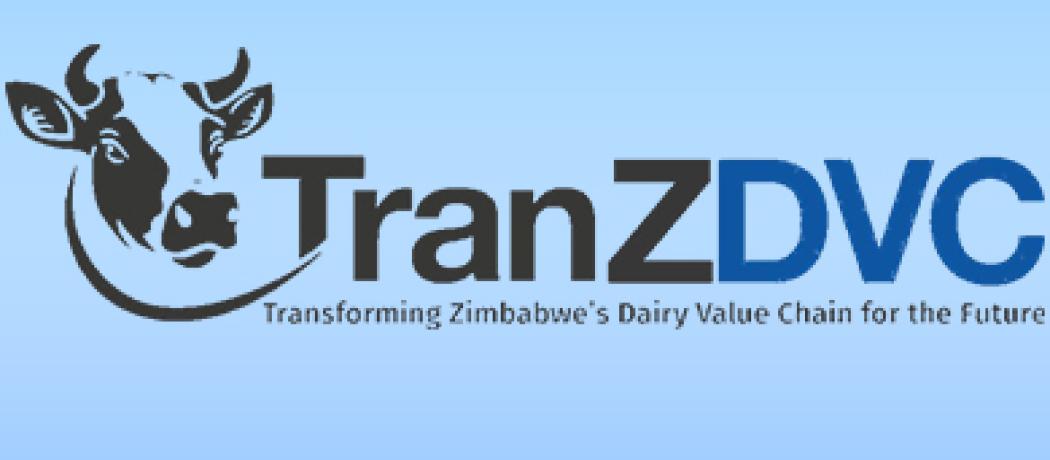
The Transforming Zimbabwe Dairy Value Chain for The Future project is being implemented under the European Union funded Zimbabwe Agricultural Growth Programme (ZAGP). ZAGP has as its overarching objective to contribute to the development of a diversified and efficient agriculture sector that promotes inclusive green economic growth. The ZAGP consists of five outcomes each addressing key constraints:
1. Increased production and productivity of the livestock sector
2. Livestock products have better access to markets and are more competitive
3. Increased public and private investment in targeted livestock value chains
4. Improved agricultural education systems and extension services
5. Institutions strengthened to develop and implement institutional and regulatory framework
TranZDVC is an 7 million Euro Dairy project funded by the European union under the Zimbabwe Agricultural growth program (ZAGP). The project runs from January 2019 to December 2022. The project was formulated to address the challenges affecting the Zimbabwe Dairy Value Chain (DVC) which include but not limited to:
✓ Low milk production (75.4 Million litres in 2018 against annual consumption of 130 million litres)
✓ High cost of production (Averaging 76% of TVC)
✓ Low cow numbers and poor breeds (27,053 pure dairy breeds, 7,071 Crosses, and 16,098 indigenous breeds)
✓ Poor Milk Collection Centre (MCC) Governance (17 out 35 MCCs operating)
✓ Limited knowledge on dairying (No Dairy qualifications on offer)
✓ Inefficient milk transportation ✓ High cost of Compliance (79 to 83 USD per cow per year)
✓ Poor dairy genetics.
✓ Poor access to finance by DVC players
✓ Low dairy farmer numbers (530 small scale dairy farmers in 2018)
✓ No electronic data base
TranZDVC Approach
✓ Exhaustive farmer trainings and farmer mobilisation
✓ Matching grant facility:
Window 1: Large scale dairy processors and large scale dairy farmers (producing more than 500 litres of milk per day) (40,000 Euro on a 50:50 match) – 18 beneficiaries targeted.
Window 2: Small scale processors and milk collection centre (10,000 Euros on a 70:30 Match) – 30 beneficiaries targeted.
Window 3: Small scale farmers (less than 200 litres of milk/day) (2000 Euro on a 70:30 match) 500 beneficiaries targeted-50% should be women
Window 4: Medium scale farmers (200 – 500Ltrs of milk per day)
Heifers: 500 in-calf heifers on a 1:1 Match
Semen: 4000 conventional and 4000 sexed semen straws.
✓ Develop a dairy sector data base.
✓ Develop a dairy sector strategic plan.
✓ Increase sector efficiency and effectiveness through DVC player capacitation.
To contribute to the development of a diversified and efficient DAIRY sector that promotes inclusive green economic growth.
Specific Objectives
❑ To improve economic, social and environmental performance of the DVC.
❑ To improve enabling environment for sustainable and inclusive DVC.
1. A comprehensive milk mapping and baseline survey was conducted. This has already been validated and published. Based on the milk mapping, efforts are being intensified in 33 districts in Zimbabwe based on:
• Milk Densities
• Dairy cow numbers/distribution
• Biophysical characteristics
• Dairy Infrastructure
2. Matching grant facility
Window 1: 9 out of 18 beneficiaries awarded.
Window 2: 24 out of 30 beneficiaries awarded.
Window 3: 128 out of 500 beneficiaries awarded (Joint applications 68, male 27, female 56 and 18 youth)
Window 4: 8 out 8 beneficiaries awarded (six joint applications and two males)
Imported 500 In-calf heifers: 347 already distributed split as 200 heifers in 2020 through large scale dairy processors,
147 heifers distributed in April 2021 directly to small scale farmers (95 at Zengea farm and 52 at Unitas farm in Kwekwe).
The last batch of 153 heifers were distributed at Zengea farm on 14 May 2021 to small scale farmers
3. Semen facility
3500 convectional semen straws and 2000 sexed semen straws so far have been procured and distribution is in progress.
4. Mobilised 3998 new farmers by December 2020 (36% were females and 64% males)
5. Milk Collection centres (MCCs)
✓ 33 out of 35 MCCs trained on business proposal development.
✓ 25 out of 35 MCCs trained on business plan development.
✓ 17 out of 35 MCCs capacitated on strategic business plans.
✓ 9 New MCCs registered in 2020.
✓ MCC management app being developed to increase MCC management efficiency and effectiveness.
✓ ISALs app being developed.
6. Dairy Data base launched . - The Server is being hosted by the Ministry of Agric.
- Tablets bought for extension staff.
- Government has donated another 30 tablets.
7. 500 copies of dairy farming practises for milk producers in Zimbabwe were printed in English, Shona and Ndebele and distributed to 97 study circles and 149 Internal Savings and Lending Schemes (ISALs).
88 lead farmers (56 males and 32 females), and 1350 farmers (945 females and 405 males) have accessed the study material.
8. 258 youth and Gender Equality Champions (132 males and 126 females and 39 (15%) youths) were identified against a target of 120.
9. 97 study circle groups were formed and capacitated against a target of 100
10. Four position papers were developed namely:
1. Reduced cost of feed
2, Institutional framework for smallholder dairy development in Zimbabwe,
3. Cost of Compliance,
4 Land Rights in dairy - 2 position papers topics for 2021 have already been selected
